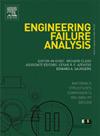Failure analysis of service fatigue cracks in aircraft structures – Going further
IF 5.7
2区 工程技术
Q1 ENGINEERING, MECHANICAL
引用次数: 0
Abstract
This paper explores the process of investigating and analysing unexpected fatigue cracking in aircraft primary structure. The three examples demonstrate the potential for quantitative fractography to assist fleet managers in answering key questions that arise in such cases, such as; the type of cracking, its nucleation cause, its age, its growth rate and its proximity to failure.
Example 1 is cracking in a BAC 1–11 main landing gear wheel that occurred adjacent to a brake-drive block fitting. The investigation revealed that the cause of the cracking was surface damage that led to intergranular corrosion pitting, from which fatigue cracking grew. Quantitative assessment using surface marking created by overhaul actions gave a crack growth curve that suggested that the crack had not been growing very fast at the time it reached the thickness of the wheel and the wheel was not close to imminent structural failure.
Example 2 investigated damage to F/A-18A/B outer wing leading edge flap attachment lugs. Fatigue cracking had nucleated from maintenance-induced damage in lug radii. The main cracks were assessed by comparison of the local fracture appearance – compared to expectation of the appearance of variable amplitude crack growth in this material gained through its close study, throughout the growth of the larger cracks to assess the growth rate, which was found to have not been growing very fast, and failure was not imminent. This was sufficient, given the short remaining life of the fleet, to support a decision not to design a fleet repair.
The third example was an investigation into F/A-18A/B vertical tail stub fatigue cracking. Here measurements of similar groups of progression markings found on the fracture surface were used to infer the fatigue crack growth rates and discreet changes in the cracks path. These markings were matched to downtime events during service life. These major markings, when correlated to the ‘similar groups of markings’ growth assessment showed good agreement, and the crack growth curve developed was used to support extending the life of the stubs with known cracking.
These studies underscore the importance of understanding the service life and event history of a structural component being examined, and the role of fatigue research in improving investigators’ practical knowledge. The authors emphasize that quantitative fractographic methods, when used in failure analysis of service aircraft structure can significantly contribute to understanding the mechanisms of fatigue crack growth and can greatly aid in fleet management decisions.
飞机结构服役疲劳裂纹失效分析——更进一步
本文探讨了飞机主结构意外疲劳裂纹的调查与分析过程。这三个例子展示了定量断口分析的潜力,可以帮助车队管理人员回答在这种情况下出现的关键问题,例如;裂纹的类型、成核原因、裂纹的年龄、裂纹的扩展速度和裂纹的失效程度。例1是在BAC 1 - 11主起落架车轮上发生的裂缝,该裂缝发生在制动驱动块配件附近。研究表明,裂纹的原因是表面损伤导致晶间腐蚀点,疲劳裂纹由此产生。通过大修产生的表面标记进行定量评估,得出了裂纹扩展曲线,该曲线表明裂纹在达到车轮厚度时并没有快速增长,车轮也没有接近即将发生的结构失效。例2研究了F/A-18A/B外翼前缘襟翼连接凸耳的损坏情况。疲劳裂纹是由维修引起的耳半径损伤形成的。对主裂纹的评估是通过局部断裂形貌的比较——与对该材料中可变振幅裂纹扩展形貌的期望进行比较,通过对其密切的研究,对整个较大裂纹的生长速率进行评估,发现其生长速度并不是很快,而且失效也不是迫在眉睫。考虑到舰队的剩余寿命很短,这足以支持不设计舰队维修的决定。第三个例子是对F/A-18A/B垂直尾翼短段疲劳开裂的调查。在这里,在断口表面发现的类似的级数标记组的测量被用来推断疲劳裂纹的扩展速率和裂纹路径的谨慎变化。这些标记与使用寿命期间的停机事件相匹配。当这些主要标记与“相似标记组”生长评估相关联时,显示出良好的一致性,并且所开发的裂纹扩展曲线用于支持延长已知裂纹的存根的寿命。这些研究强调了了解被检测结构部件的使用寿命和事件历史的重要性,以及疲劳研究在提高研究人员实践知识方面的作用。作者强调,定量断口学方法用于现役飞机结构的失效分析,可以显著有助于理解疲劳裂纹扩展的机制,并可以极大地帮助机队管理决策。
本文章由计算机程序翻译,如有差异,请以英文原文为准。
求助全文
约1分钟内获得全文
求助全文
来源期刊

Engineering Failure Analysis
工程技术-材料科学:表征与测试
CiteScore
7.70
自引率
20.00%
发文量
956
审稿时长
47 days
期刊介绍:
Engineering Failure Analysis publishes research papers describing the analysis of engineering failures and related studies.
Papers relating to the structure, properties and behaviour of engineering materials are encouraged, particularly those which also involve the detailed application of materials parameters to problems in engineering structures, components and design. In addition to the area of materials engineering, the interacting fields of mechanical, manufacturing, aeronautical, civil, chemical, corrosion and design engineering are considered relevant. Activity should be directed at analysing engineering failures and carrying out research to help reduce the incidences of failures and to extend the operating horizons of engineering materials.
Emphasis is placed on the mechanical properties of materials and their behaviour when influenced by structure, process and environment. Metallic, polymeric, ceramic and natural materials are all included and the application of these materials to real engineering situations should be emphasised. The use of a case-study based approach is also encouraged.
Engineering Failure Analysis provides essential reference material and critical feedback into the design process thereby contributing to the prevention of engineering failures in the future. All submissions will be subject to peer review from leading experts in the field.
 求助内容:
求助内容: 应助结果提醒方式:
应助结果提醒方式:


